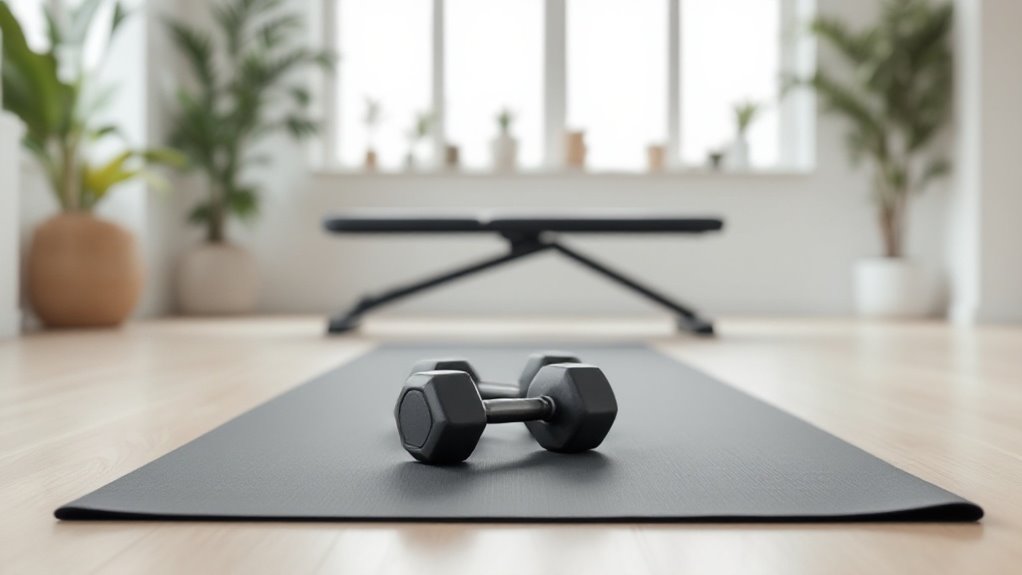How to Do a Split Squat

To perform a split squat, start by taking a step forward into a staggered stance with feet hip-width apart. Raise the back heel and distribute weight primarily on the front foot. Lower the body by bending both knees until they form 90-degree angles, keeping the front knee over the toes. Drive through the front heel to return to the starting position. Master proper form with bodyweight before adding weights for ideal strength gains and athletic performance benefits.
Key Takeaways
- Take a staggered stance with one foot forward and one back, lifting your back heel off the ground.
- Keep your torso upright and core engaged while bending both knees until they form 90-degree angles.
- Maintain your front knee aligned over your toes and avoid letting it cave inward during the movement.
- Drive through your front heel to return to the starting position, keeping your hips square throughout.
- Begin with bodyweight squats to master form before progressing to weighted variations like dumbbells or kettlebells.

Mastering the split squat is vital for developing lower body strength, balance, and athletic performance. This foundational exercise targets multiple muscle groups simultaneously while improving stability and coordination, making it a valuable addition to any fitness routine. Athletes and fitness enthusiasts alike benefit from incorporating split squats into their training regimen, as the movement closely mimics real-world athletic movements and daily activities. Progressive overload principles are essential for women looking to build strength through split squats and other compound movements.
To execute a proper split squat, one begins by standing with feet hip-width apart. Taking a step forward with one leg, approximately two to three feet in length, the individual positions themselves in a staggered stance. The back heel should be raised, with the weight distributed primarily between the front foot and the ball of the back foot. Maintaining an upright torso with shoulders back and core activated is key for proper form and injury prevention.
The descent phase involves lowering the body by bending both knees simultaneously. The front knee should track over the toes without extending past them, while the back knee lowers toward the ground. The ideal depth is achieved when both knees form roughly 90-degree angles. Throughout the movement, the hips remain square and facing forward, preventing any twisting or lateral movement that could compromise form and effectiveness.
The ascent requires driving through the front heel while maintaining balance and control. The glutes and quadriceps of the front leg work in tandem to power the movement upward. Common mistakes include leaning too far forward, allowing the front knee to cave inward, or rushing through the movement without maintaining proper control and tempo.
For beginners, starting with bodyweight split squats helps establish proper form and build foundational strength. As proficiency increases, adding dumbbells, kettlebells, or barbells can provide progressive overload.
Advanced variations include raising the back foot on a bench or incorporating dynamic movements. Like any exercise, consistency and proper form are key to achieving ideal results and preventing injury.
Regular practice of split squats leads to improved leg strength, improved balance, and better overall athletic performance.
Frequently Asked Questions
Can Split Squats Help Reduce Knee Pain During Regular Squats?
Split squats can effectively reduce knee pain during regular squats by strengthening stabilizer muscles and improving single-leg balance.
The unilateral movement pattern helps identify and correct muscle imbalances while building strength in a controlled manner.
Athletes experiencing knee discomfort often find that incorporating split squats into their routine improves proper squat mechanics and reduces joint stress.
How Many Split Squats Should Beginners Do per Workout Session?
Like a young sapling growing strong roots, beginners should start with 2-3 sets of 8-10 split squats per leg during each workout session.
This allows proper form development and gradual strength building. As stability and confidence improve over 2-3 weeks, they can progress to 3-4 sets of 12-15 reps per leg.
Rest periods between sets should be 60-90 seconds for ideal recovery.
Are Split Squats Better Than Lunges for Building Leg Muscle?
Split squats and lunges both effectively build leg muscle, but split squats often provide superior muscle activation.
The stationary position of split squats allows for better form control and deeper range of motion, particularly targeting the quads and glutes.
However, lunges offer unique benefits through their dynamic movement pattern.
For ideal results, incorporating both exercises into a leg routine enhances muscle development through complementary movement patterns.
Should I Do Split Squats Before or After My Regular Squats?
Split squats are typically best performed after regular squats.
Regular squats are a primary compound movement that requires maximum energy and focus, making them ideal to perform while fresh.
Since split squats are an accessory exercise that targets more specific muscle groups, they're more effective when implemented later in the workout.
This sequence optimizes strength gains and reduces the risk of form breakdown during the main lift.
Can I Do Split Squats if I Have Lower Back Problems?
Split squats can be safe for those with lower back issues when performed correctly.
They actually help strengthen the core and stabilizing muscles while putting less direct stress on the spine compared to regular squats.
However, individuals with back problems should start with bodyweight versions, focus on proper form, and consult a healthcare provider before beginning.
Progress slowly and stop if pain occurs.
Final Thoughts
Split squats deliver exceptional results for leg strength and stability. Research from the Journal of Strength and Conditioning Research shows that athletes who incorporated split squats into their training saw a 12% increase in sprint speed over an 8-week period compared to traditional squats alone. By mastering proper form and consistently integrating this exercise, anyone can improve their athletic performance and lower body functionality.


